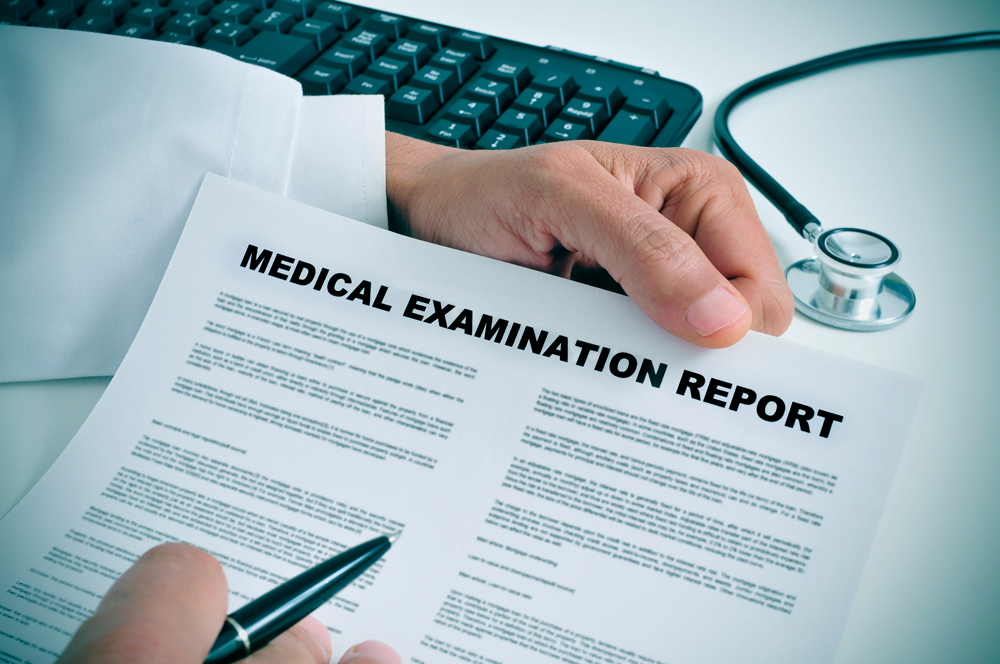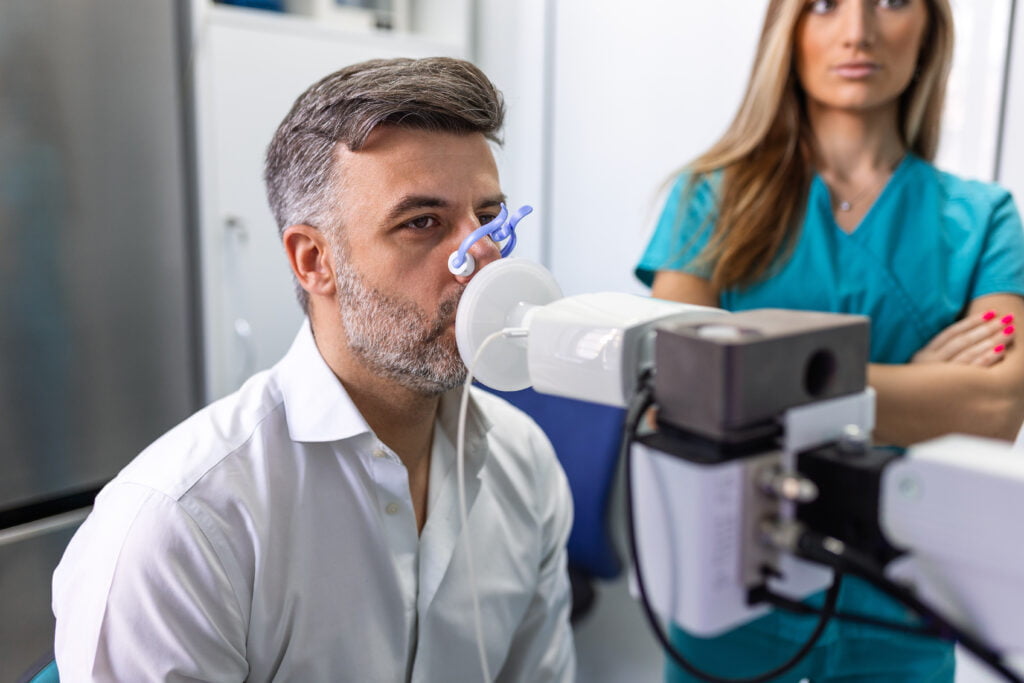In industries which involve exposure to dust, fumes, or other airborne particles, regular lung function tests are a vital part of health surveillance. They not only protect employees from potential health complications, but also help employers remain compliant with relevant legislation and avoid legal issues.
Lung Function Testing: The Basics
(1) What Is a Lung Function Test?
A lung function test, or pulmonary test, includes several assessments that evaluate lung performance. These tests measure how much air the lungs can hold, how quickly you can inhale or exhale, and how effectively the lungs exchange oxygen and carbon dioxide. The assessment’s main goal is to detect and monitor lung conditions that could affect an employee’s ability to work safely. This concern is especially relevant in industries with exposure to airborne substances that risk lung health.
(2) When Is Lung Function Testing Used?
Use lung function testing to respond to specific workplace exposures or as a periodic health assessment. It helps monitor early signs of respiratory problems. You can also include it in pre-employment screenings to ensure an employee is fit for their role.
(3) What Types of Lung Function Tests Are There?
There are several types of lung function assessments, each evaluating a different aspect of lung function:
Spirometry: This is the most common type of lung function testing. It measures how much air a person can exhale and how quickly. Use it to diagnose conditions like asthma, chronic obstructive pulmonary disease (COPD), and other breathing disorders.
Peak Flow Measurement: Similar to spirometry, this test measures how much air can be exhaled and how quickly. The main differences lie in the equipment and details provided. Spirometry offers more detailed insights and is usually conducted by a professional. In contrast, peak flow measurement uses a handheld device, allowing patients to monitor their lung function regularly on their own.
Gas Transfer Testing (Diffusion Capacity): This test measures how well the lungs transfer oxygen from the air into the bloodstream. It is especially useful for employees exposed to substances that may cause long-term lung damage, allowing for early intervention if abnormalities are detected.
Body Plethysmography: This advanced lung function test measures the amount of air left in the lungs after full exhalation, providing detailed information about lung volumes. It is particularly useful in complex cases requiring a thorough assessment of lung function.

What Happens at a Lung Function Test?
(1) The Testing Process
Lung function testing is straightforward, but accurate results require proper execution. Here’s a step-by-step guide to what happens during a typical lung function test:
Pre-Test Preparation
- Employee Instructions: Before the test, employees receive instructions to avoid activities and substances that could affect lung function. They should refrain from smoking, heavy meals, and vigorous exercise for a few hours before the test. Employees may also be asked to avoid using inhalers or other respiratory medications unless specifically instructed by their healthcare provider.
- Medical History: The healthcare professional conducting the test will review the employee’s medical history. This includes any respiratory conditions, medications, and recent illnesses, as these factors can influence the results.
During the Test
- Spirometry Test: The employee sits comfortably and wears a nose clip to prevent air from escaping through the nose. They then take a deep breath in and exhale as forcefully and quickly as possible into a spirometer. This device measures the volume and speed of air expelled from the lungs. The test may be repeated several times to ensure consistent and accurate results.
- Other Tests (if applicable): If additional tests are needed, such as body plethysmography, they will follow specific protocols. The healthcare professional will provide clear instructions for each test.
(2) Lung Function Test Results
Interpreting lung function test results involves comparing the measured values to standard reference values. These values are based on factors like age, gender, height, and ethnicity. Comparing them helps determine if the employee’s lung function is within the normal range or if there are signs of respiratory issues.
Spirometry Results
- FVC (Forced Vital Capacity): This measures the total amount of air exhaled after taking the deepest breath possible. A lower-than-normal FVC may indicate restrictive lung diseases, where the lungs cannot fully expand.
- FEV1 (Forced Expiratory Volume in one second): This measures how much air can be forcefully exhaled in the first second. A lower-than-normal FEV1 may indicate obstructive lung diseases, such as asthma or COPD, where airflow is restricted.
- FEV1/FVC Ratio: This ratio helps differentiate between obstructive and restrictive lung diseases. A lower ratio typically suggests an obstructive pattern, while a normal or high ratio with reduced FVC indicates a restrictive pattern.
Peak Flow Results
Peak flow readings are compared to normal values based on age, gender, and height. Consistently low readings can indicate poorly controlled asthma or other obstructive airway conditions.
Gas Transfer and Other Tests
Results from gas transfer testing and body plethysmography are compared to normal values. Deviations from these norms can indicate lung tissue damage, airway obstruction, or other pulmonary issues.
(3) Post-Test Follow-up
Follow-up after lung function testing is crucial, especially if the results indicate any abnormalities. Here’s what typically happens post-test:
- Normal Results: If the results are within the normal range, the employee may not need further testing until the next scheduled evaluation, depending on workplace guidelines and exposure risks.
- Abnormal Results: If the results are abnormal, additional tests may be recommended to investigate the underlying cause. This could include more detailed lung function tests, imaging studies, or blood tests.
- Further Testing: In some cases, the employee may be referred to a pulmonologist or specialist for a more comprehensive evaluation and management plan.
- Work Adjustments: If the results show that an employee’s respiratory health may be compromised by their current work environment, adjustments may be made to their duties or work area to reduce exposure to respiratory hazards.
- Ongoing Monitoring: Employees with identified respiratory conditions may require more frequent monitoring to track the condition’s progression and the effectiveness of any interventions.

What Employers Need to Know About Lung Function Testing
In today’s workplace, maintaining a healthy and safe environment is both a legal requirement and a critical factor in driving productivity and reducing costs.
(1) Reducing Absenteeism
Respiratory issues often cause absenteeism, especially in industries where employees are exposed to dust, fumes, or chemicals. Regular lung function testing helps identify issues early, allowing for timely adjustments and treatment. This approach can significantly reduce sick leave, as employees receive the care they need before their condition worsens.
(2) Regulatory Compliance
According to the Health and Safety at Work etc. Act 1974 and the Control of Substances Hazardous to Health (COSHH) regulations, employers have a legal duty to protect their workforce from health risks, including respiratory risks. The Management of Health and Safety at Work Regulations 1999 also require employers to assess and manage health risks at the workplace.
Regular lung function tests are a key component of meeting these obligations, helping to ensure that any potential health problems are either avoided or detected in a timely manner and managed appropriately.
(3) Supporting a Healthy and Productive Workforce
A healthy workforce is a productive workforce. Regular lung function testing supports long-term employee health by detecting respiratory issues early and enabling effective management. Employees who know their health is actively monitored and protected are more likely to stay motivated and engaged, leading to higher morale and reduced turnover.
Moreover, showing a commitment to employee health can enhance your company’s reputation, making it an attractive place to work. This can be a significant competitive advantage in industries where skilled labor is in high demand.
Implementing a Lung Function Testing Program
Having to implement a lung function testing programme at your organisation may seem a bit complicated and intimidating at first. However, with careful planning and adequate support, the process becomes straightforward.
(1) Logistics
One of the primary challenges in setting up a lung function testing program is the logistical and financial burden. For smaller businesses, the cost of equipment and training can be a significant concern. Scheduling tests without disrupting regular work activities can also be difficult, especially in industries with tight deadlines and shift work.
In such cases, consider partnering with a specialized occupational health provider like Healthscreen. We offer mobile testing units and flexible scheduling options, reducing the need for expensive equipment and allowing on-site testing with minimal disruption.
(2) Accuracy and Reliability of Tests
Improper use of equipment and environmental factors like temperature and humidity can influence test results. To ensure accuracy, it’s crucial to follow best practices. Partnering with a professional provider is the best way to achieve this. Trained professionals will perform the tests, use the equipment correctly, and provide clear instructions to employees, ensuring they understand and follow them.
(3) Privacy and Confidentiality
Privacy and confidentiality are major concerns for employees when it comes to health data. Employees may worry about how their lung function test results will be used, who will have access to the information, and whether the results could impact their employment status. These concerns can lead to reluctance in participating in the testing.
At Healthscreen, all test results, including those from lung function assessments, are handled in compliance with the Data Protection Act and GDPR. This means that employees are informed about how their data will be used, and consent is always obtained before testing. Additionally, results are shared with employers in an aggregated, anonymised format unless specific consent is given by the employee to release individual results.

Lung Function Testing FAQ
What to expect during a lung function test?
Lung function tests are straightforward and non-invasive, but it’s natural for employees to have questions or concerns about the process.
Typically, a lung function test involves sitting comfortably while following instructions from the healthcare professional.
For spirometry, the most common lung function test, the employee takes a deep breath and then exhales as forcefully as possible into a mouthpiece connected to the equipment. The test may be repeated several times to ensure accurate results.
How often should lung function testing be conducted?
The frequency of lung function testing depends on factors like the industry, the substances employees encounter, and how often and long they are exposed.
In higher-risk industries, employees should undergo at least one lung function test per year. In lower-risk workplaces, testing every two to three years is typically sufficient.
Can lung function testing detect all respiratory issues?
Lung function testing is a powerful tool for detecting and monitoring respiratory issues, but it has limitations.
Spirometry, for example, can detect asthma, chronic obstructive pulmonary disease, and other obstructive or restrictive lung diseases. However, it may not detect diseases affecting only small airways or those in their very early stages.
Additionally, lung function testing may not identify conditions related to lung blood vessels or lung infections.
What is involved in a lung function test?
A lung function test involves several steps to measure different aspects of lung capacity and function.
The most common test, spirometry, measures how much air you can exhale and how quickly you can do so.
Other tests, like peak flow measurement, assess the maximum speed of exhalation. Gas transfer tests evaluate how well oxygen passes from the lungs into the bloodstream. The process usually involves breathing into a mouthpiece connected to a machine that records the results.
What are the 4 lung function tests?
The four main types of lung function tests include:
- Spirometry: Measures the volume and speed of air you can exhale.
- Peak Flow Measurement: Assesses the maximum speed of exhalation.
- Gas Transfer Test (Diffusion Capacity): Evaluates how well oxygen transfers from the lungs to the blood.
- Body Plethysmography: Measures total lung capacity, including the volume of air remaining after full exhalation.
How long does a lung function test take?
The duration of a lung function test depends on the type of test. A standard spirometry test typically takes about 15 to 30 minutes, including preparation and multiple test attempts to ensure accuracy. More comprehensive tests, such as gas transfer testing or body plethysmography, may take up to 45 minutes.
What happens if a lung function test is bad?
If lung function test results are abnormal, it’s important not to panic and to follow up with further evaluation.
The healthcare provider will review the results in detail and may recommend additional tests to determine the cause of the abnormal findings. Depending on the results, the provider may refer the employee to a specialist, such as a pulmonologist, for further investigation and management.
Abnormal results may also prompt a reassessment of the employee’s work environment or tasks to reduce exposure to respiratory hazards.
Are lung function tests available on the NHS?
Yes, lung function tests are available on the NHS, but they are typically offered under specific circumstances. The NHS offers lung function tests as part of a broader health screening program for individuals aged 55 to 74 who have smoked.
What is a lung capacity test?
A lung capacity test, also known as spirometry, measures the amount of air a person can inhale and exhale, as well as how quickly they can exhale.
How to improve lung function test results?
Improving lung function test results involves adopting healthy habits that support respiratory health.
Regular cardiovascular exercise, such as walking, jogging, or swimming, strengthens the lungs. Avoiding smoking and exposure to pollutants or allergens also significantly enhances lung function. Additionally, practicing deep breathing exercises can help increase lung capacity.
For employees in environments with respiratory hazards, using proper protective equipment and ensuring good ventilation further protect and improve lung function over time.
Healthscreen’s Lung Function Testing Service
Healthscreen offer a lung function testing service designed to assess your employees’ respiratory health quickly and efficiently. Our testing procedures only take about 10 minutes, streamlined for minimal disruption to the operations of your business. Furthermore, all assessments are carried out by our experienced staff who are highly trained to provide accurate and reliable results. We not only help you ensure compliance with regulations, but also reduce absenteeism and productivity at your workplace.
To learn more about our lung function testing service or to request a free, no-obligation quote, get in touch with Healthscreen today. Our friendly team is here to guide you every step of the way.






